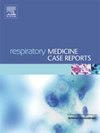Safety and efficacy of osimertinib 160 mg daily given concurrently with a strong CYP3A4 inducer
IF 0.7
Q4 RESPIRATORY SYSTEM
引用次数: 0
Abstract
Introduction
Osimertinib remains the standard first-line therapy for patients with advanced EGFR-mutant NSCLC, at least in part due to its improved CNS penetrance compared to earlier generation EGFR TKIs. Strong CYP3A4-inducing medications are known to reduce the effective concentration of osimertinib, prompting the recommendation to double the standard osimertinib dose from 80 to 160 mg daily. However, little is known about the real-world safety and efficacy of osimertinib given in combination with long term CYP3A4 inducer use. We detail, to our knowledge, the first reported case of a patient receiving an escalated osimertinib dosage concurrent with a potent CYP3A4 inducer.
Case presentation
A 69-year-old-female with a long-standing history of a seizure disorder was diagnosed with stage IV EGFR exon 19 deletion positive lung adenocarcinoma. After a failed trial to wean the patient off phenytoin, osimertinib at a dose of 160 mg in combination with phenytoin was recommended based on existing clinical guidelines. She achieved a partial response and continues with stable disease for more than 32 months from initiation of osimertinib. Additionally, she tolerated osimertinib well with minimal side effects although with persistent dyspnea of unclear etiology.
Conclusion
Our case illustrates that 160 mg of osimertinib administered concurrently with a strong CYP3A4 inducer can be given safely and with retained efficacy in treating CNS metastatic EGFR-positive non-small cell lung cancer.
奥希替尼每天160毫克与强CYP3A4诱导剂同时服用的安全性和有效性
奥西替尼仍然是晚期EGFR突变NSCLC患者的标准一线治疗,至少部分原因是与早期EGFR TKIs相比,奥西替尼改善了中枢神经系统外显率。已知强cyp3a4诱导药物会降低奥希替尼的有效浓度,因此建议将标准奥希替尼剂量加倍,从每天80毫克增加到160毫克。然而,对于奥西替尼与长期使用CYP3A4诱导剂联合使用的实际安全性和有效性知之甚少。我们详细介绍,据我们所知,第一例报告的患者接受升级的奥西替尼剂量同时服用强效CYP3A4诱导剂。病例介绍:一名69岁女性,有长期癫痫发作病史,被诊断为IV期EGFR 19外显子缺失阳性肺腺癌。在一次让患者戒除苯妥英的试验失败后,根据现有的临床指南,推荐使用剂量为160毫克的奥西替尼与苯妥英联合使用。她获得了部分缓解,并从开始使用奥西替尼开始病情稳定超过32个月。此外,她对奥希替尼耐受性良好,副作用最小,尽管有病因不明的持续性呼吸困难。结论本病例表明,160mg奥西替尼联合强效CYP3A4诱导剂治疗中枢神经系统转移性egfr阳性非小细胞肺癌安全有效。
本文章由计算机程序翻译,如有差异,请以英文原文为准。
求助全文
约1分钟内获得全文
求助全文
来源期刊

Respiratory Medicine Case Reports
RESPIRATORY SYSTEM-
CiteScore
2.10
自引率
0.00%
发文量
213
审稿时长
87 days
 求助内容:
求助内容: 应助结果提醒方式:
应助结果提醒方式:


